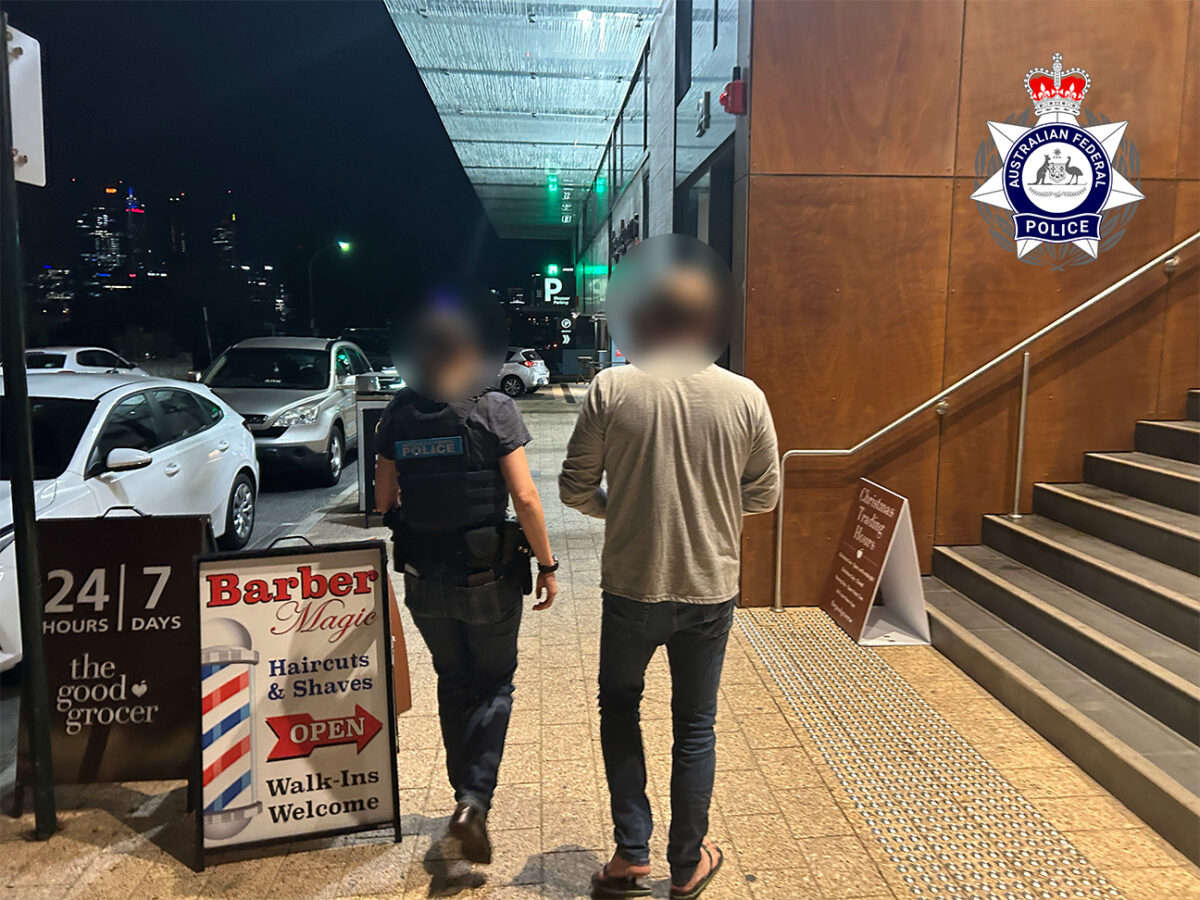Footage Shows Kenyan Police Fired at Journalist Covering Protests
Journalist Catherine Wanjeri Kariuki was wearing a bright yellow hoodie underneath her beige-coloured vest emblazoned with the word “PRESS” when three pellets fired by Kenyan police lodged in her left thigh.
Kariuki is a Kenyan broadcast reporter with Kameme TV and Mediamax. She was standing with fellow journalists at the intersection of Pandit Nehru Road and Kenyatta Avenue in downtown Nakuru, a city in western Kenya, when she was shot with a less-lethal weapon at close range.
Less-lethal weapons also known as non-lethal weapons are often used in crowd control situations by police but can potentially be lethal depending on how they are used.
Footage and images captured at the scene on July 16 reveals that a police officer shot towards a group of eight unarmed people including several journalists from a moving police vehicle.
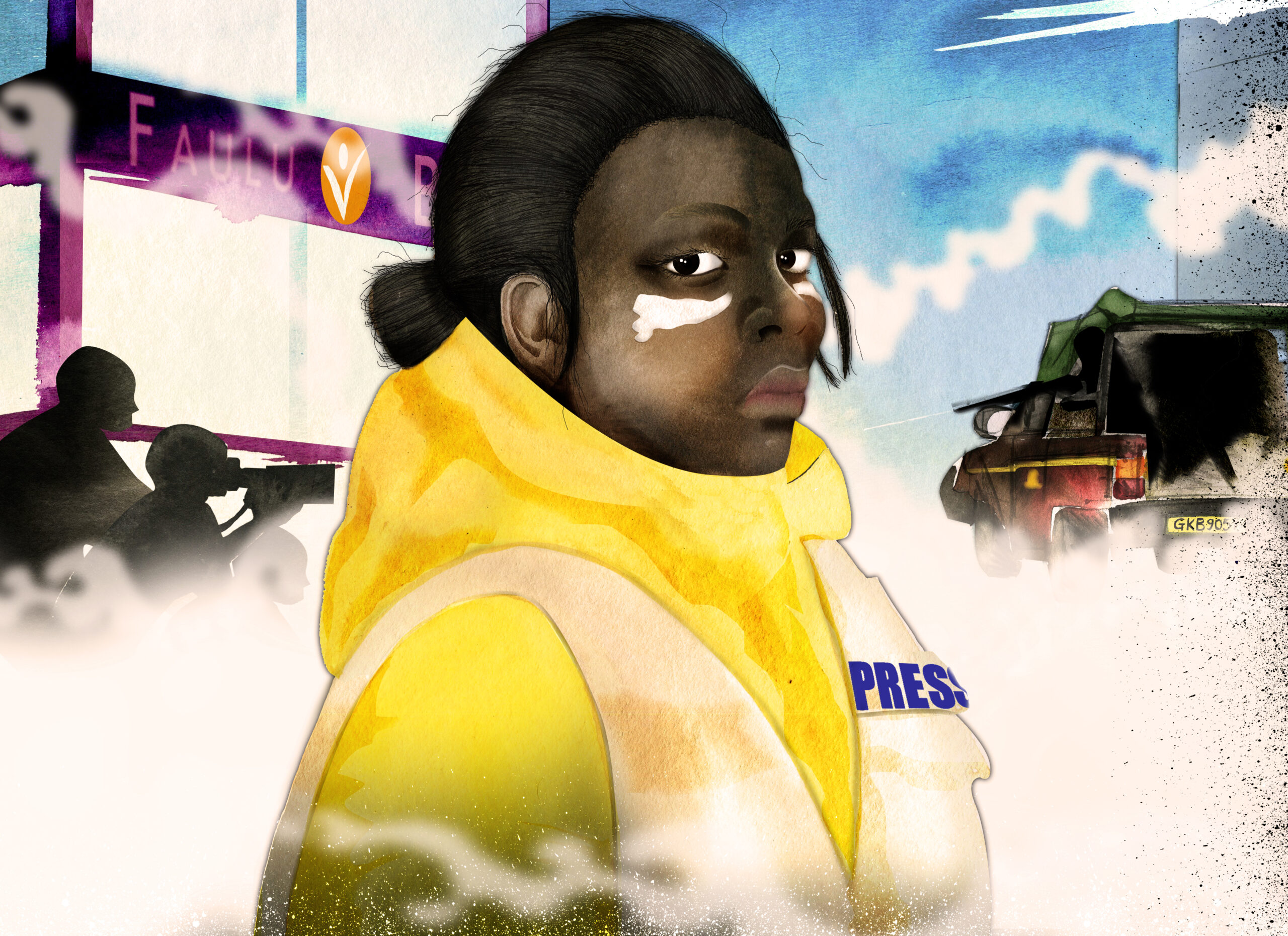
The use of force appears to violate multiple rules outlined in Kenya’s National Police Service Act. The Sixth Schedule of the Act outlines that:
- “A police officer shall always attempt to use non-violent means first and force may only be employed when non-violent means are ineffective…”
- “The force used shall be proportional to the objective to be achieved, the seriousness of the offence, and the resistance of the person against whom it is used…”
- “When the use of force results in injuries -the police officers present shall provide medical assistance immediately and unless there are good reasons, failing to do so shall be a criminal offence…”
Bellingcat was not able to identify the police officer responsible for the shooting, however footage appears to show it was the person seated behind the driver’s seat of the police vehicle, licence plate GKB905Y.
More than 40 people have been killed since anti-finance bill demonstrations began in June this year. Kenya’s police chief resigned last month over the police response to the protests but accountability for police brutality has been hard to come by in Kenya. Amnesty International and Human Rights Watch have previously documented multiple incidents of excessive use of force by police and the independent body formed to investigate the issue – the Independent Police Oversight Authority (IPOA) – has consistently struggled to secure convictions against police officers.
Nakuru County Police Commander, Samuel Ndanyi told Bellingcat the incident involving Kariuki was “unfortunate” but denied police fired from their vehicles at reporters. He said the case has been handed over to IPOA to investigate.
Bellingcat contacted IPOA to ask about the status of the investigation, but they had not responded at time of publication.
Journalist Catherine Wanjeri Kariuki told Bellingcat she wants the case to be properly investigated so that more journalists do not become a target of police.
“Journalists are tired and fed up of being suppressed and being told to keep quiet when they shouldn’t.”
While there have been more lethal incidents during the anti-finance bill protests in Kenya, video evidence from this case shows exactly how a police weapon was used, seriously injuring a journalist who posed no threat.
Protests Spread Across Kenya
Widespread street protests began in Nairobi and quickly spread across the country on June 18, as people took to the streets to oppose a finance bill that would raise taxes.
At least 23 people were killed in violent clashes between police and protesters at parliament in Nairobi. Protests have continued even after Prime Minister William Ruto withdrew the bill and fired the majority of his cabinet. Kenya’s National Commission on Human Rights (KNCHR) reports at least 50 people have been killed since protests began.
On the day Kariuki was shot, protesters had gathered in the downtown of Kenya’s third largest city, Nakuru.
Demonstrators in Downtown Nakuru
Protesters began to gather on Tuesday morning along Kenyatta Avenue.
Protesters can be seen marching down the street with whistles, and vuvuzela. Armed Kenya Defense Forces (KDF) and police can also be seen on the streets.
A number of KDF forces were deployed to Nakuru in late June to guard the government office in the city, they can be seen in footage wearing camouflage but some deployed police were also in camouflage.
A livestream by KTN News captured a small number of protesters speaking to the media at 1:55pm local time, just outside the Faulu Microfinance Bank, located here at the intersection of Kenyatta Avenue and Pandit Nehru Road.
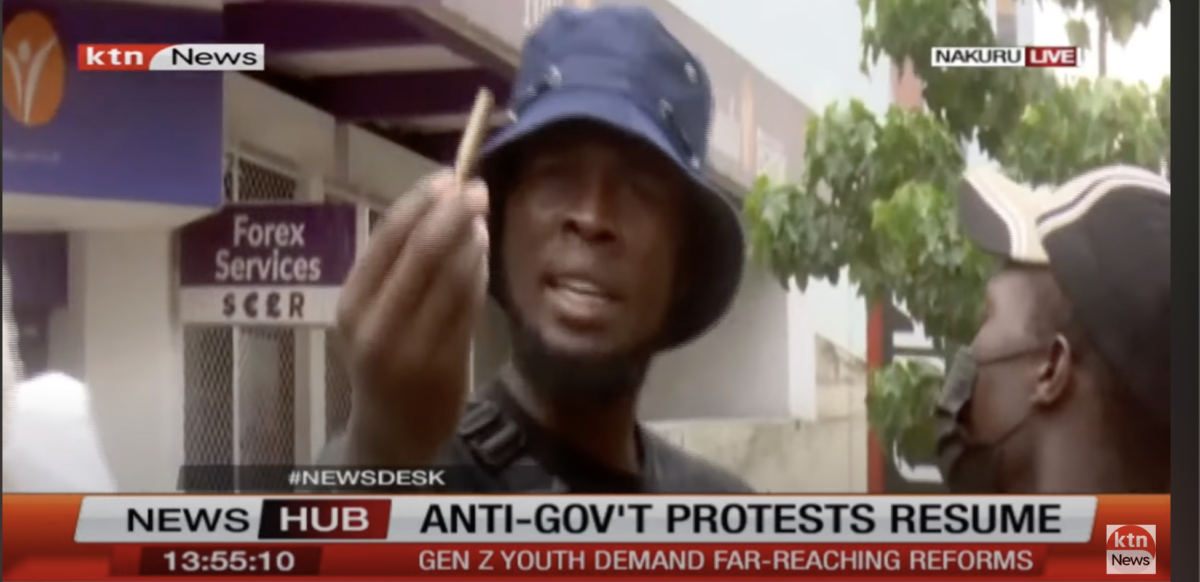
Local media also showed footage of protesters being dispersed with tear gas along Kenyatta Avenue.
Throughout the day news crews were present at the intersection of Kenyatta Avenue and Pandit Nehru Road in downtown Nakuru. Footage shows a small number of protesters at the site and traffic continuing to move through the area at about 2pm.
About an hour later, footage captures four mounted police officers turn onto Kenyatta Avenue and head north along Pandit Nehru Road.
Police Shoot towards Kariuki and Other Journalists
At least two videos captured the exact moment of the shooting- from slightly different angles. One video was captured from amongst the journalists in front of Faulu Microfinance Bank – the other from the opposite side of the intersection.
You can watch the footage side-by-side, below:
Sources: Mutembei Archived from Facebook and Twitter.
In the footage we can see the mounted police turn up Pandit Nehru Road. While the police vehicle GKB905Y follows behind.
The vehicle then drives straight down Kenyatta Avenue for one more block (heading east), before it stops near a Total Energies petrol station and performs a U-turn. The number ‘226’ can be seen under its side mirror.
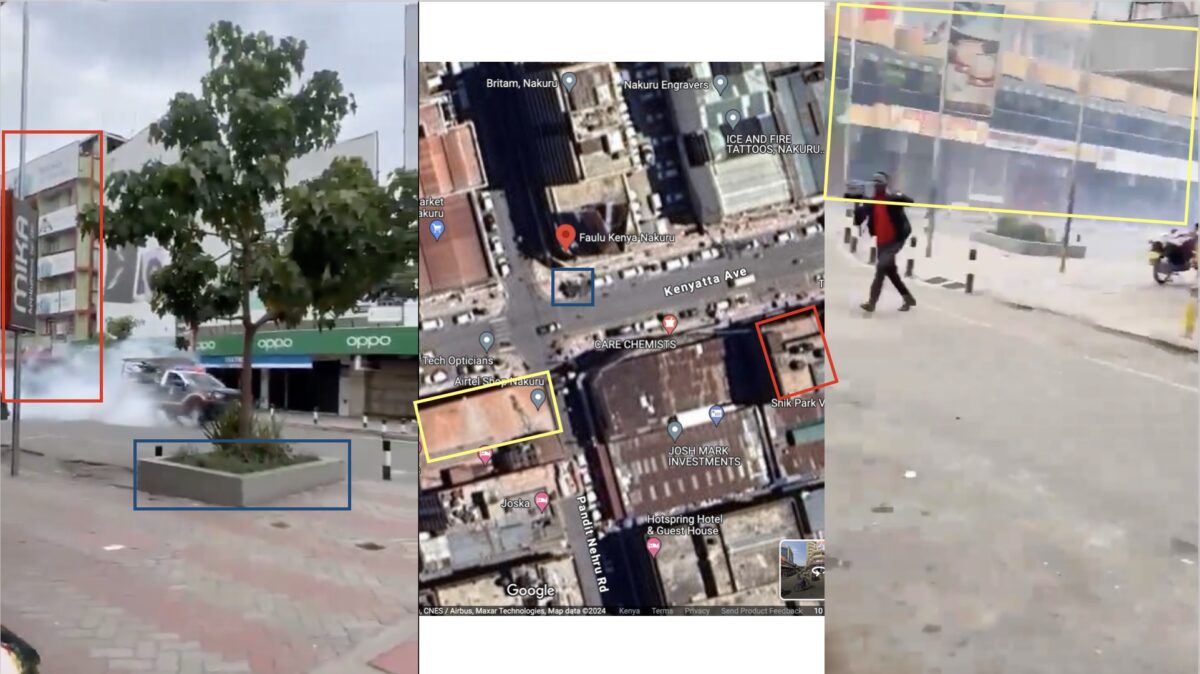
Many shops appear to be closed between Faulu Bank and Total Energies – where the police vehicle turns around – and the street appears to be mostly empty, apart from a large number of what appear to be KDF troops walking along the street.
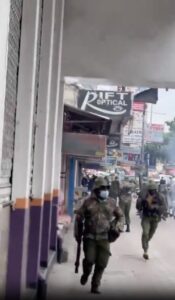
In addition to police and KDF forces, footage and images show that multiple journalists were located at the intersection of Kenyatta Avenue and Pandit Nehru, in particular in front of Faulu Bank, here: -0.283751, 36.073842– a collection of several journalists stood with their notepads and cameras.
Two of them, including Kariuki, were wearing distinctive press jackets, another was holding a TV camera.
Kariuki, can be seen in yellow hoodie and beige press vest, moments prior to the shooting as the jeep drives past the first time.
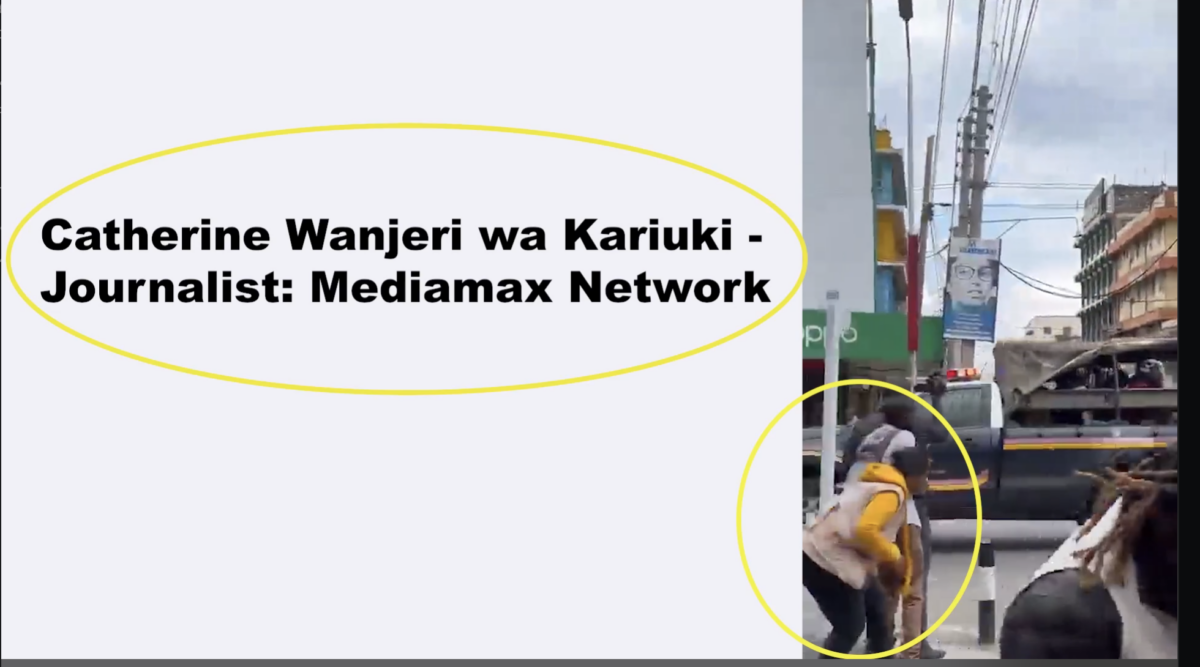
None of the eight people standing in front of the Faulu Bank are armed, and they do not appear to pose any threat to the KDF forces or police.
A number of armed KDF can be seen walking next to the journalists in front of Faulu Bank and at no point do they appear to be threatened by the people gathered on the corner.
Just before GKB905Y turns the corner, footage shows a shot being fired from the back of the vehicle. This appears to come from the person located directly behind the driver’s seat, although the face of the officer can not be made out.
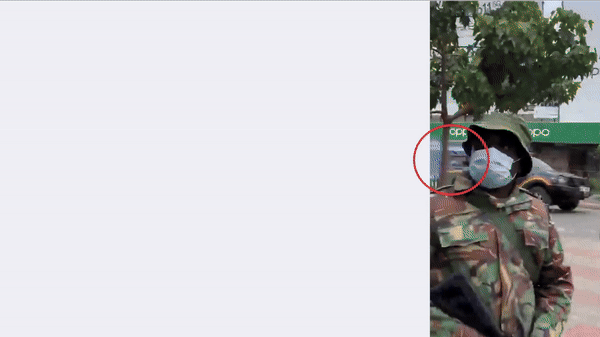
After the shot is fired, the vehicle turns the corner into Pandit Nehru Road and footage filmed on the opposite side of the street shows Kariuki – in her yellow hoodie and press vest- collapse to her knees.
Meanwhile, footage captured from Faulu Bank – just next to Kariuki- shows the police officer located behind the driver’s seat lift up their visor, apparently to get a better look at the scene. Bellingcat was unable to identify the officer responsible for the shooting.
Before leaving the area, a third shot is fired from the police vehicle as it drives up Pandit Nehru Road.
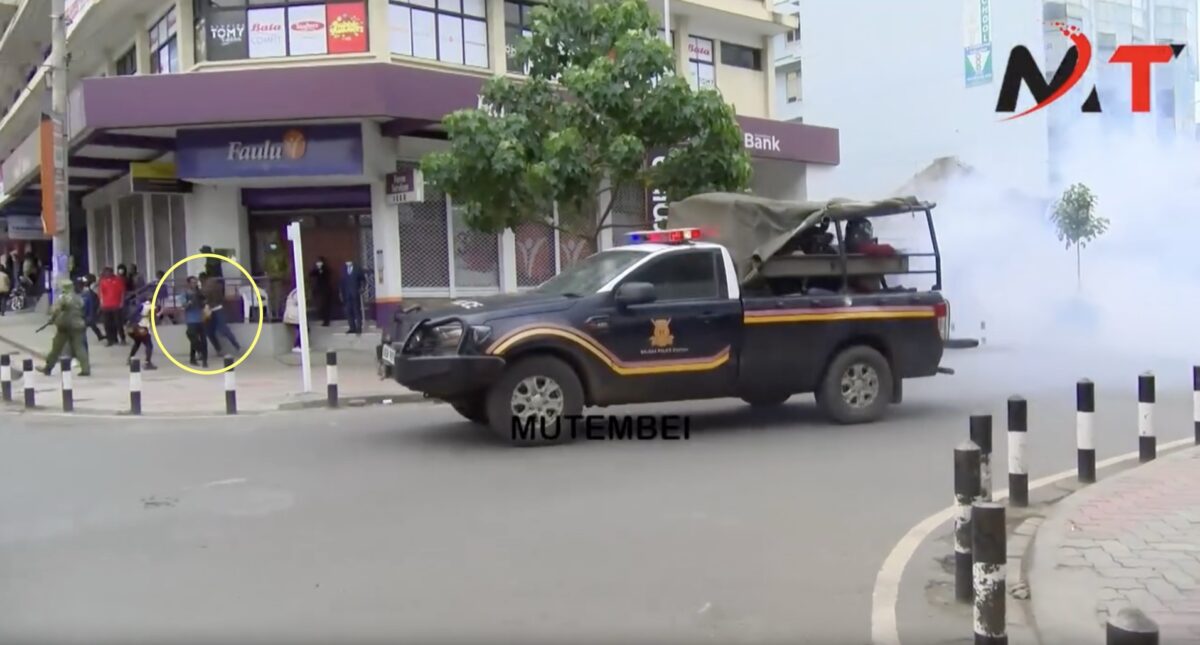
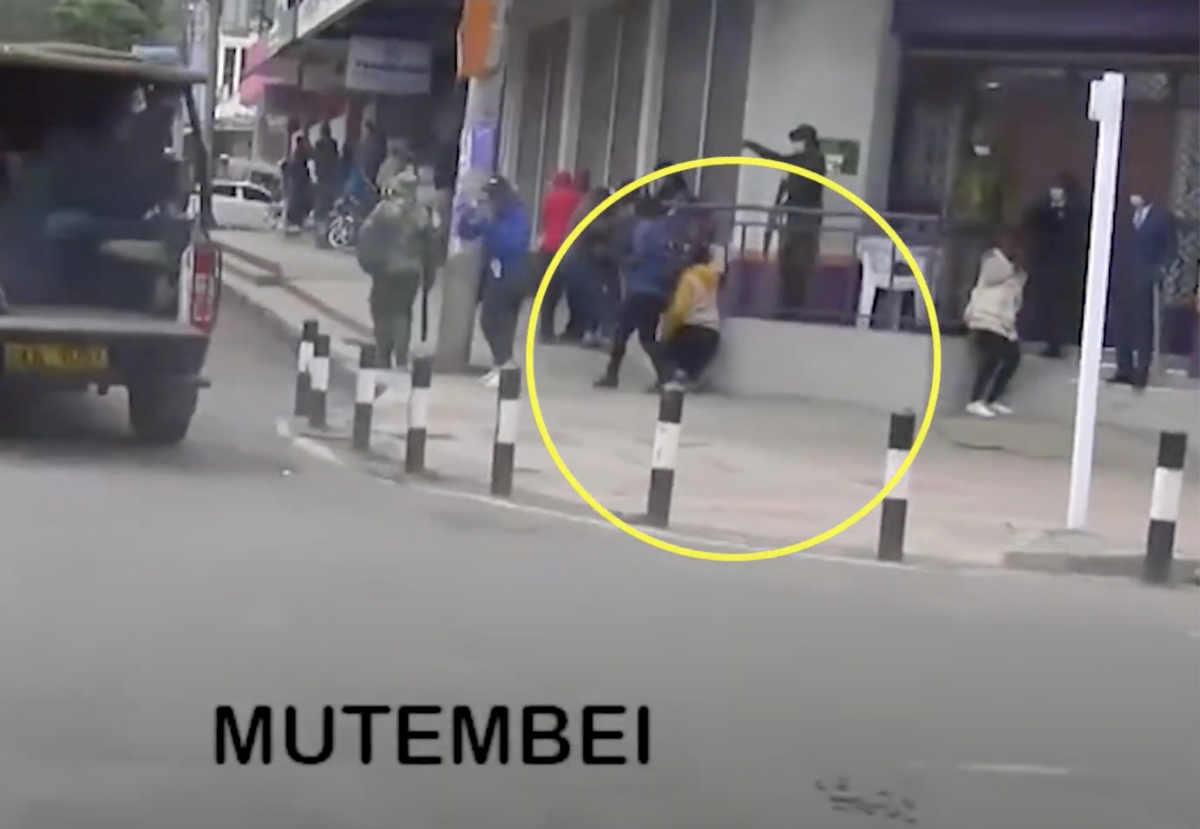
As Kariuki collapses to the ground, a camera approaches, and at least two entry wounds can be seen on her left thigh.
A second man in jeans and a brown jacket – seen standing next to Kariuki- can also be seen on the ground, apparently also sustaining injuries from the shot fired. However his injuries can not be clearly made out in the footage.


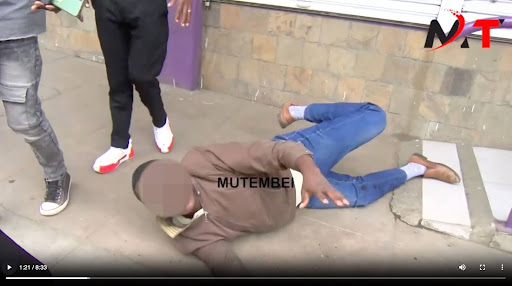
Both Kariuuki and the man and loaded onto motorbikes and driven from the scene.
Weapons Carried by Police in GKB905Y
Four police officers can be made out, sitting in the back of police vehicle GKB905Y. Some are wearing helmets with “Police” written on them.
At least two officers appear to be armed with the same weapon – a relatively older model of a tear gas launcher. The distinctive white canister can be seen loaded in the weapons at various points in the footage and tear gas is fired from the vehicle at various points in the footage.

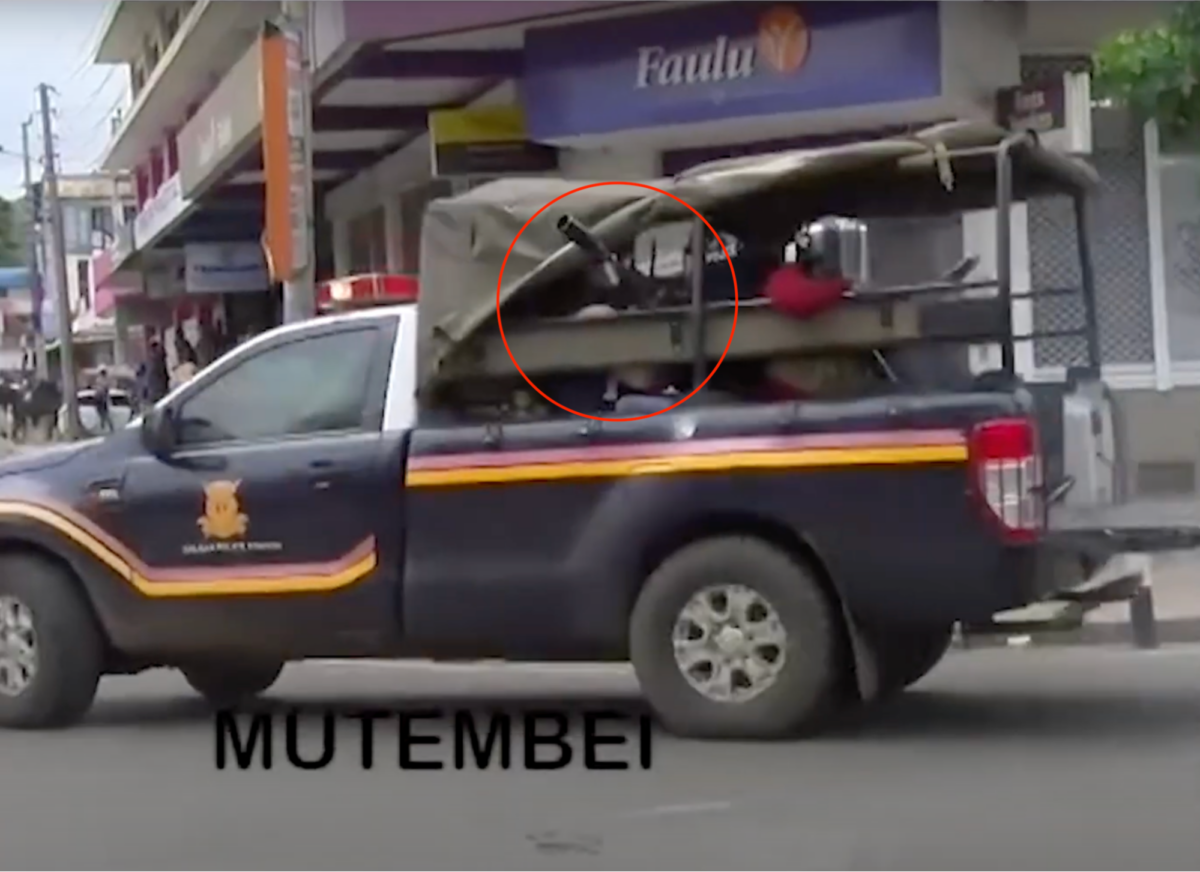
The person – seated immediately behind the driver- is hard to make out and we can’t see the weapon they were carrying. But we can clearly see a ‘puff’ from a gunshot fired from this position. Measuring the distance between the vehicle and the group’s location indicates the shot was fired from less than ten metres away. Bellingcat obtained images of the three pellets later removed from Kariuki’s leg at a hospital – suggesting the weapon was a model which fires pellets or rubber bullets of some kind.
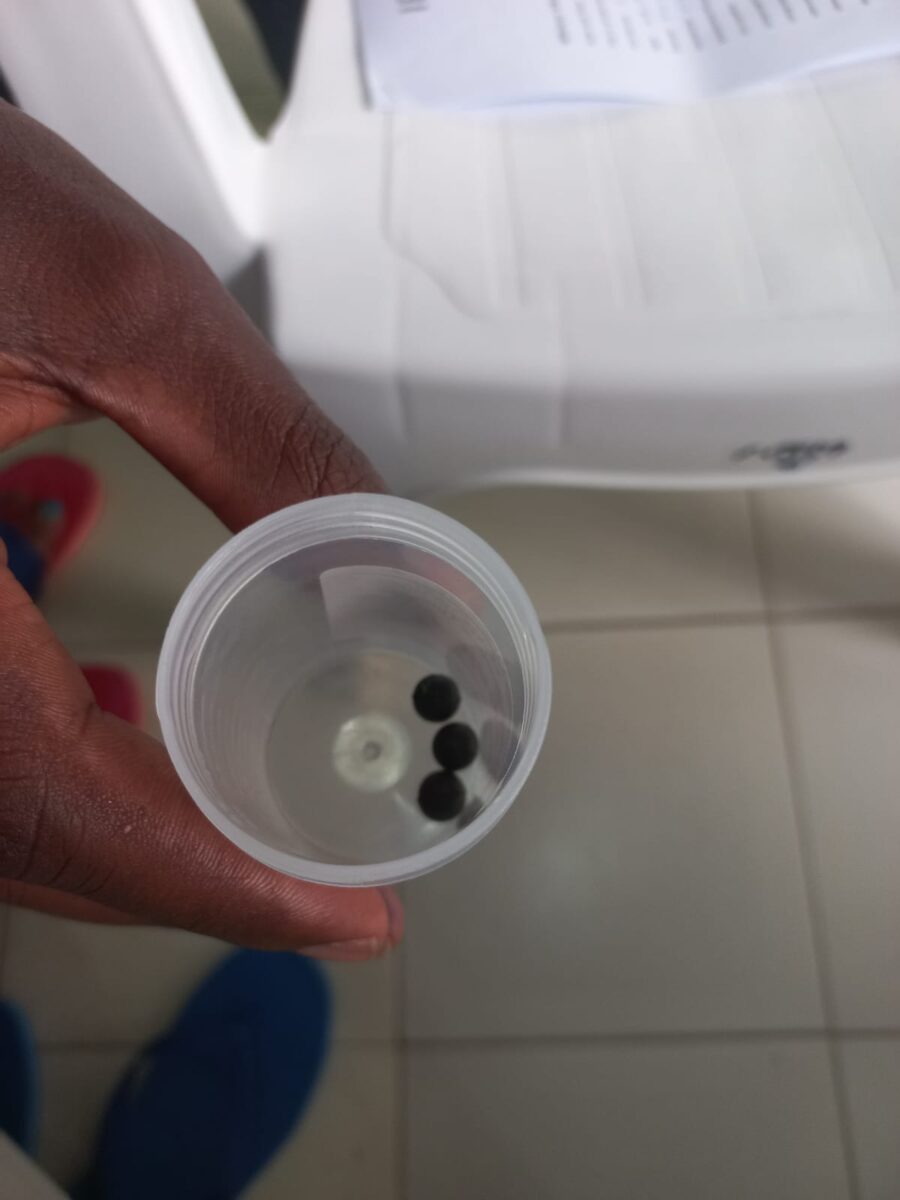
Kariuki’s medical report from the Provincial General Hospital – Annex where she underwent surgery states:
“Patient presented after being involved in a shooting sustained [three] penetrating injuries to the left thigh.”
An Amnesty International paper on the use of kinetic weapons, such as rubber bullets and other projectiles, outlines that these weapons should only be used in “exceptional circumstances” and considered on the upper level of the use of force scale, just below lethal firearms.
“This means their use can only be justified if it is to prevent another person from being severely injured and not for any lower risk than this…Furthermore, it is unacceptable that a kinetic impact projectile will injure other persons who do not present such a threat.”
The Kenya Human Rights Commission (KHRC) has reviewed footage of the shooting. Ernest Cornel, communications lead at KHRC, told Bellingcat:
The use of force violates the rules outlined in Kenya’s National Police Service Act and violates international standards, such as the United Nations Basic Principles on the Use of Force and Firearms by Law Enforcement Officials, which emphasise that force should be used only when absolutely necessary and in a way that is proportional to the threat.
“The actions depicted clearly violate international guidelines on the use of less-lethal weapons and force, as well as international laws that protect freedom of expression, peaceful assembly, and association.”
In addition to the unnecessary and excessive use of force, the firing towards journalists and other civilians represents a threat to the rights of freedom of expression and peaceful assembly, he said.
Cornel said Kenyan police need to review how the use of force has been deployed in response to protests, adding that the shooting of Kariuki suggests a broader issue with police response tactics during protests. The officer responsible should be suspended from duty while the investigation is carried out and the officer’s superiors should also be held accountable if there is evidence they failed to prevent misconduct or condoned it.
Additionally KHRC urges IPOA to conduct a swift investigation into cases of police misconduct.
“Accountability is not only about addressing the actions of the individual officer but also about examining the systemic issues that allowed the misconduct to occur.”
Other Incidents that Day
In addition to the shooting of Kariuki, police in Nakuru were reportedly involved in a number of other incidents in the city that day.
A young man was allegedly injured by a rubber projectile fired by police earlier that day. Bellingcat was unable to confirm how he was injured but footage shows him being carried by three people from a shop towards a minivan. Bellingcat geolocated the video to around -0.284510, 36.070994 – approximately 300 metres from where Kariuki was shot on Kenyatta Avenue.
Bellingcat also chronolocated the footage to around 11:35 – 12:25.
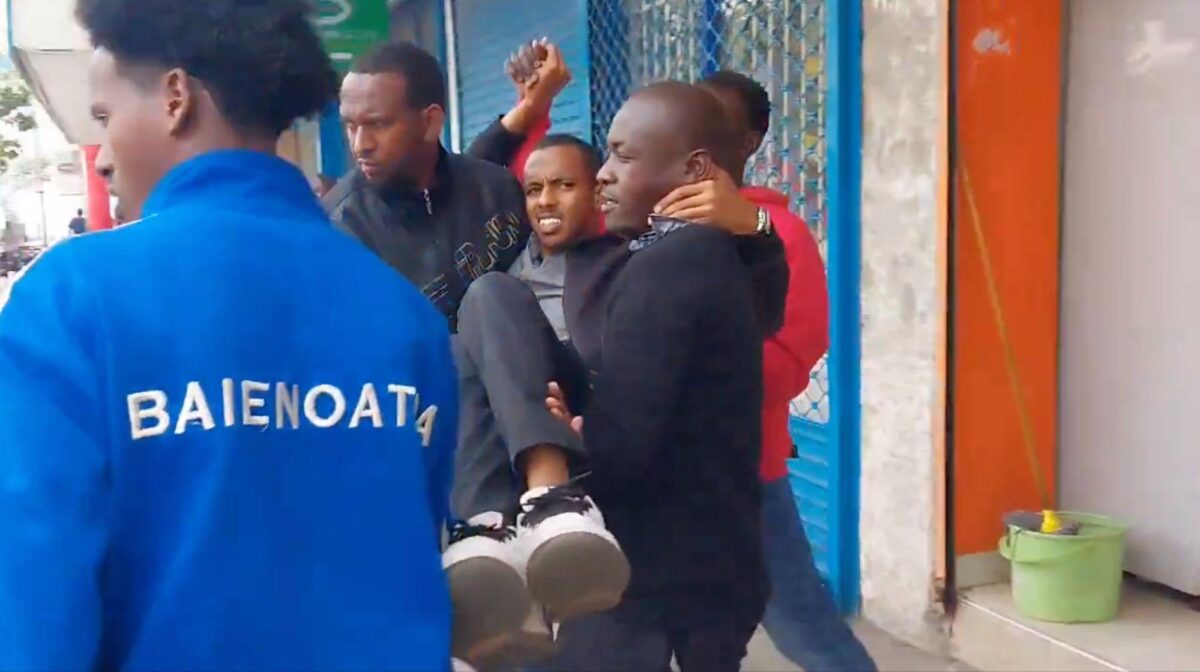

Additionally Citizen TV Kenya posted a video around 17:35 which appears to show the CCTV footage from the Chosen Generation Church, showing police members inside the church and people lying on the ground.
Citizen TV Kenya reported that protesters took refuge inside the church when police officers stormed it and detained one person. The time stamp in the footage reads 14:59.
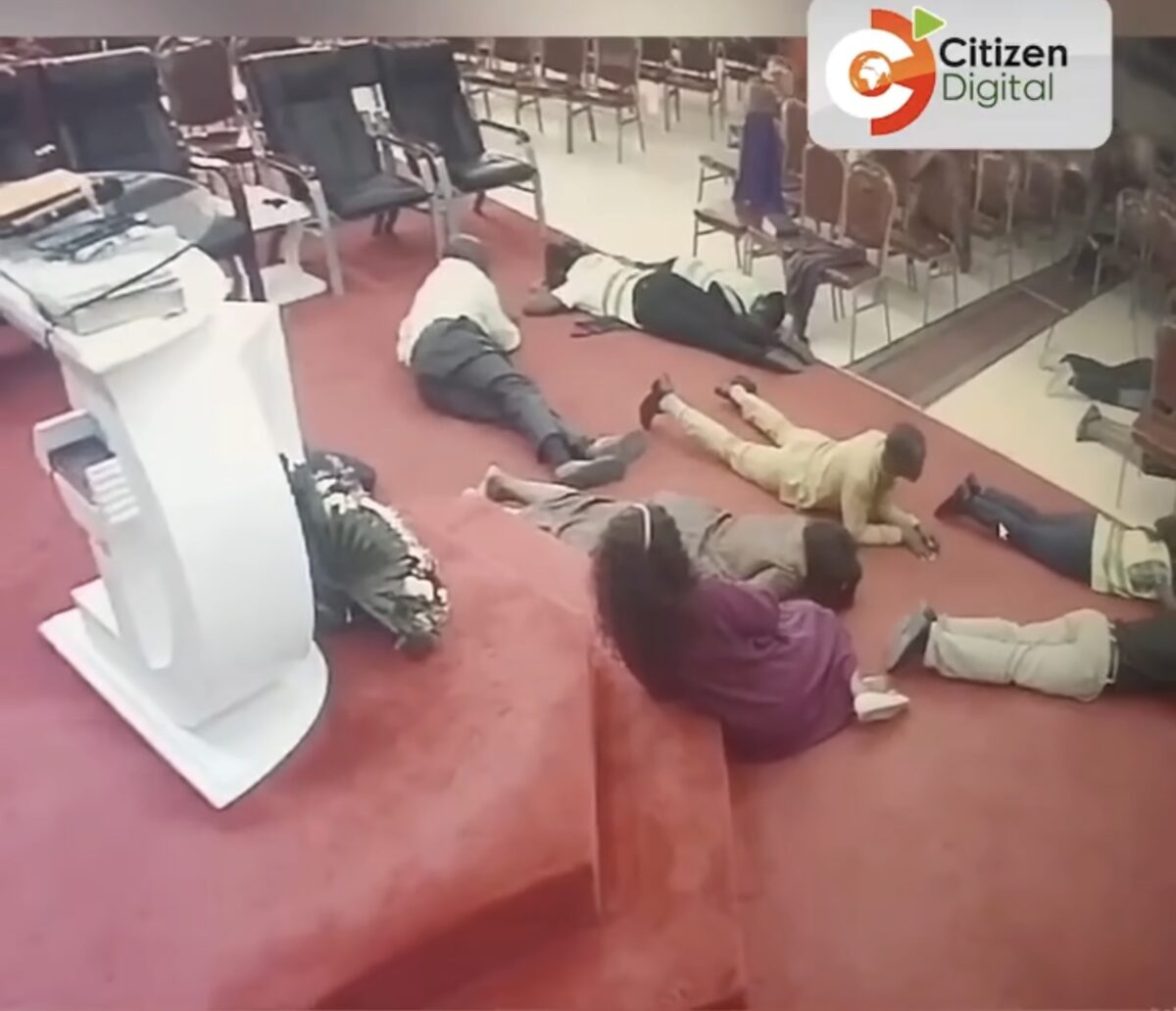
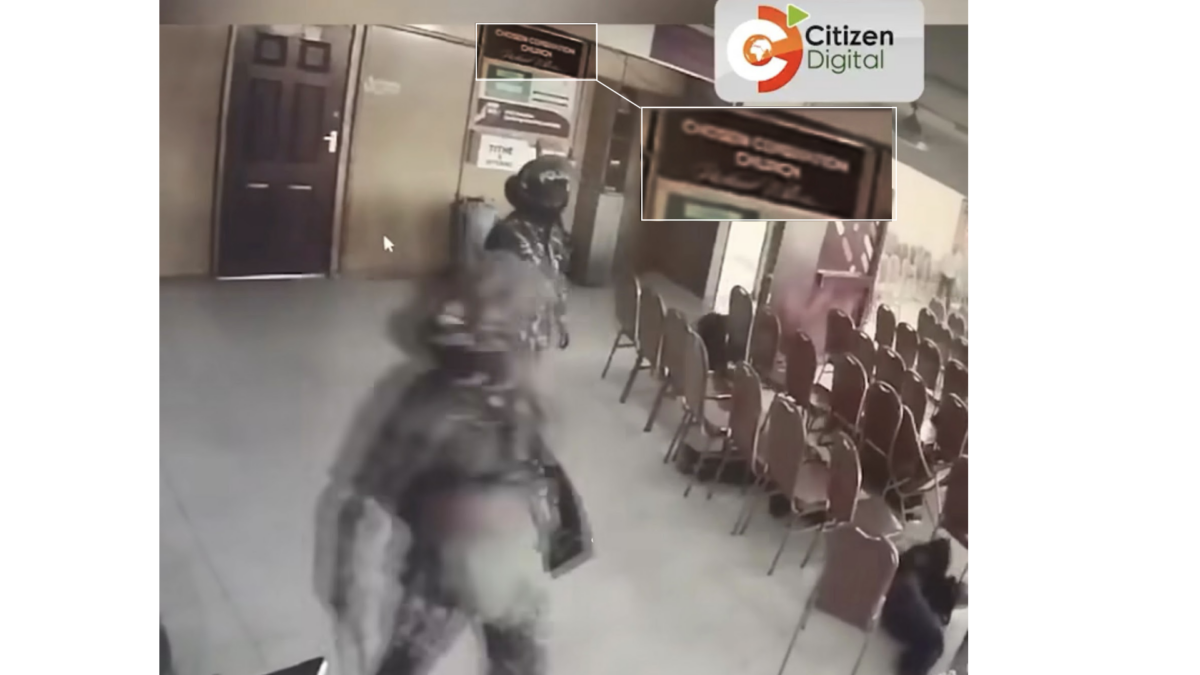
A sign that reads “Chosen Generation Church” can be seen at the top of the frame. Source: Twitter.
The Shooting from Kariuki’s Point of View
Kariuki told Bellingcat that protesters were concentrated in a small area of the city and she was moving between Kenyatta Avenue and other main roads when she was shot.
A tear gas canister had been fired in her direction earlier that day, but it happened while she was near Kenyan police officers, so she assumed it was an accident, she said.
Kariuki had been reporting from the streets for about two hours when she was shot in front of Faulu Bank.
“It was only journalists and some police officers who were manning one of the microfinance banks, around that place.”
Because it happened so quickly she couldn’t identify the officer who shot at her.
Kariuki told Bellingcat that she wants the case to be properly investigated. Achieving accountability in this case is important because of the wider threat facing journalists, she said. Kariuki has filed a complaint with IPOA but is worried that the investigation may drag on and that no one will be ultimately held accountable.
“It’s my prayer that one month doesn’t elapse before I’m given an update.”
“I talk about press freedom because I’m not the only journalist who has been attacked.”
Police Response
Nakuru County Police Commander, Samuel Ndanyi told Bellingcat he had not seen footage of the shooting and denied police fired from their vehicle at reporters.
“We did not have any police officers firing from the moving vehicle towards the journalists.”
He said police were deployed to the area to disperse protesters, and described the incident as “quite unfortunate”.
“No police officer left his or her house with an intention that they were going to do what happened,” Ndayni told Bellingcat.
He did not answer questions about whether use of force guidelines were followed. He said a number of officers had recorded statements about the incident but he said he did not know if the officer involved had been suspended.
Ndanyi told Bellingcat the case is currently being investigated by IPOA and said he was awaiting the results of this probe.
Bellingcat contacted IPOA to ask about the status of the investigation and when the findings would be published, but they had not responded at time of publication.
Bellingcat also contacted The Office of the Attorney General and Department of Justice to ask about this incident and wider issues of police accountability, but had not received a response at time of publication. So far no one has been held accountable for the shooting.
Since Kairuki was shot, the International Press Association (IPA) of East Africa reported that at least three journalists were injured while covering anti-finance bill protests in Nairobi earlier this month when they were hit with tear gas fired at close range.
Bellingcat is a non-profit and the ability to carry out our work is dependent on the kind support of individual donors. If you would like to support our work, you can do so here. You can also subscribe to our Patreon channel here. Subscribe to our Newsletter and follow us on Twitter here and Mastodon here.
